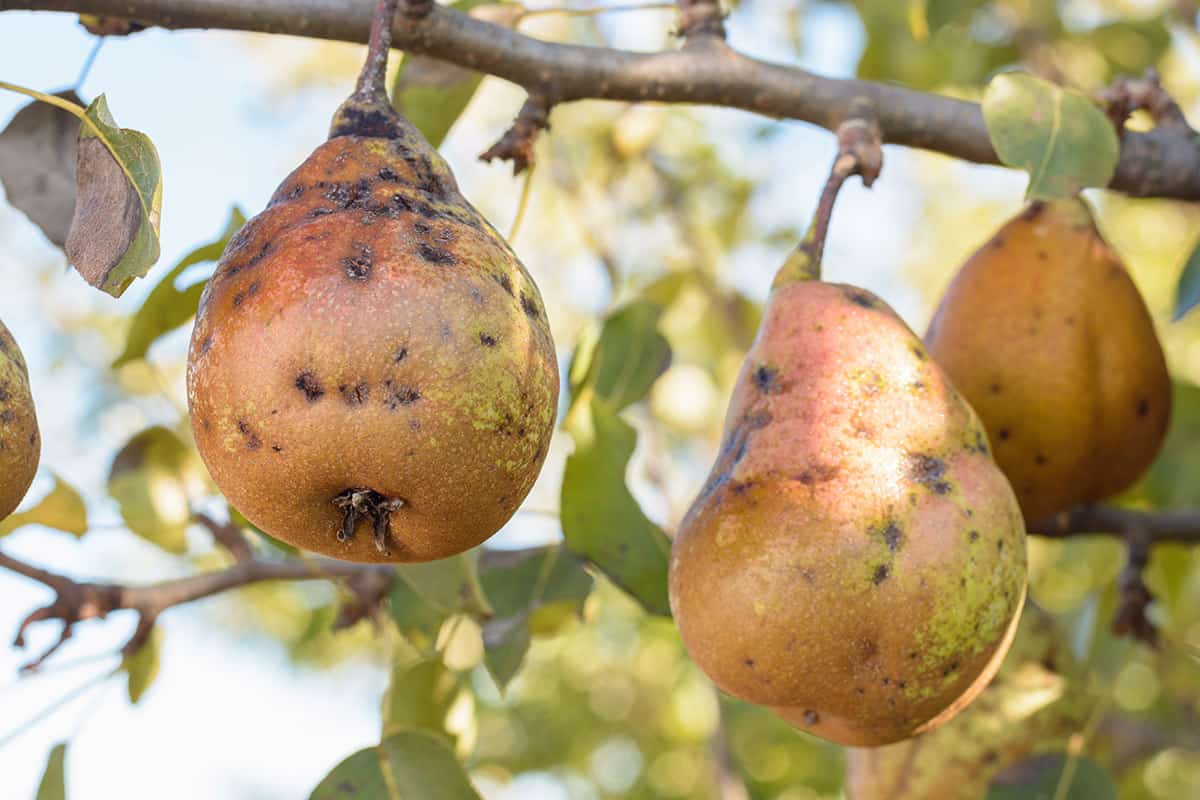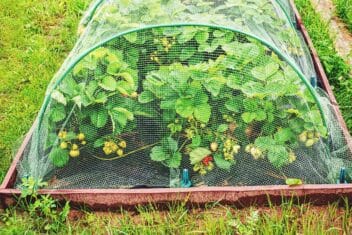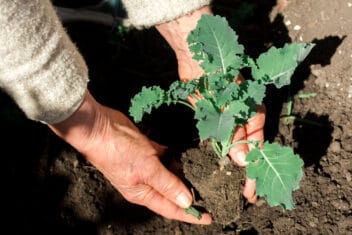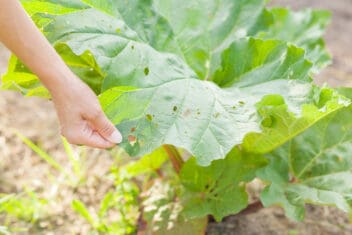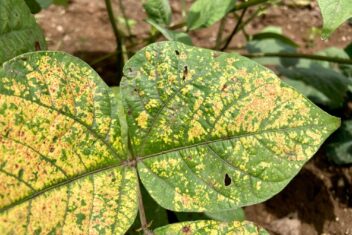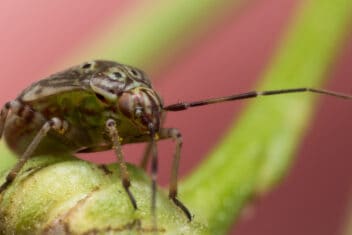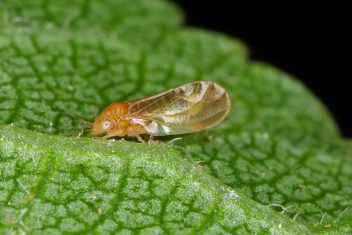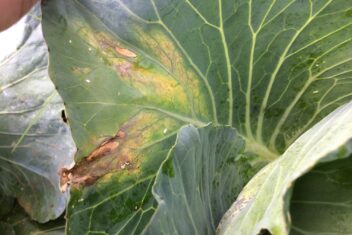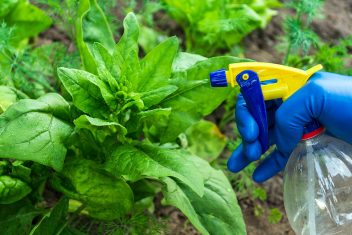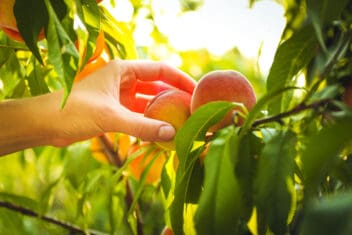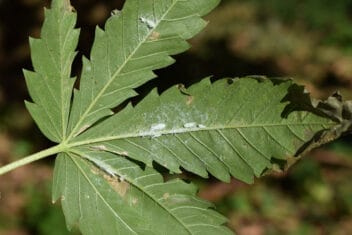Homegrown pears are delicious, and pear trees are one of the easiest fruits trees to grow in your backyard orchard. Don’t risk losing that tasty harvest! Keep an eye out for these pear tree pests and diseases that can seriously damage your tree.
Pear trees are one of the first fruit trees that gardeners try to grow, along with apple trees, and while they’re not a gardening challenge, they do (like all plants) suffer from some issues. Let’s take a look at what problems you might face.
4 Pear Tree Pests
Pear pests can range from no biggie to seriously damaging. The pests that don’t impact your harvest can spread disease, so you still need to get them under control.
1. Aphids

It seems like aphids love to infect all sorts of plants, including pear trees. These tiny pests group underneath the leaves, sucking out the plant juices and leaving a secretion behind called honeydew. This leaves a growth media for sooty mold to form on your pear trees.
Typically, aphid infestations aren’t a huge deal unless they get out of hand. You can knock them off the tree with jets of water from your hose. Neem oil or other insecticidal oils kill the eggs; many insecticides work for aphids.
Learn more about aphids and how to deal with them in your garden.
2. Codling Moth
Ever heard of a codling moth? Most people don’t know about these pear pests, but they cause a lot of damage to fruit trees. They like to burrow and cause holes in the pear fruits; these holes are often blocked with brown frass (insect excrement). Some holes are shallow, but others burrow deeply into the fruit, reaching the core.
It’s important to understand the lifecycle of a codling moth; they produce up to four generations per year. So, they easily infest your garden. The larvae tend to cause the most damage to your pear trees.
Preventative measures are essential, so make sure you learn proper fruit tree care techniques. Pear trees need to be pruned, keeping their canopy open. You also can use applications of Entrust and kaolin clay to treat these pests.
Most home gardeners opt to remove infested fruit by hand before the larvae leave the fruit. That’s an easy way to reduce the population. If you notice an infected fruit, toss it out or burn it to stop them from coming out and going to the next one!
3. Leafrollers
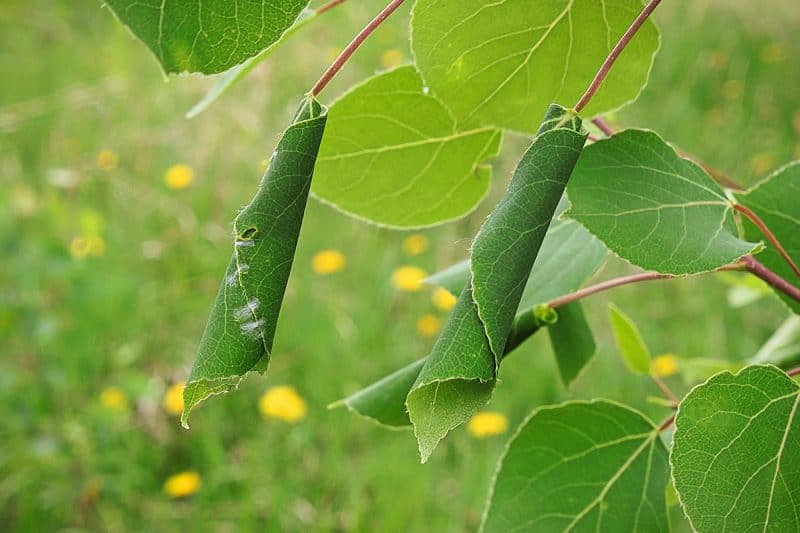
These insects roll up the leaves of the pear tree and tie them together with silk webbing. Then, the leafrollers – clever name, right? – feed on the damaged, rolled leaves, causing the defoliation of your fruit tree.
You might also notice silk webbing on the fruits, and the fruits might have scarring from feeding damage. The larvae cause the most damage to the pear trees, so monitor for any signs of the adult moth in your garden.
If you end up with an infestation of leafrollers on your pear tree, use Entrust or Bacillus thuringiensis. These are effective, organic treatment options. Make sure you spray carefully; it needs to get inside of the rolled leaves where the larvae like to hide and feed.
4. Pear Psylla
One pear tree pest that is known to cause serious problems is the pear psylla. This is a damaging pest for pear trees, and it’s known for developing a resistance to most insecticide options. An infestation causes rapid and total reduced tree vigor, eventually killing the tree with a disease called pear decline.
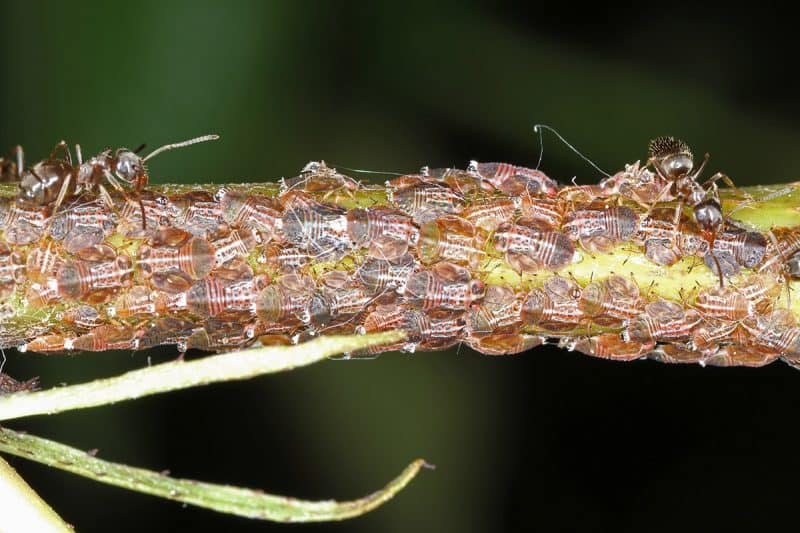
If you end up with pear psylla pests in your garden, use insecticidal oils and kaolin clay to get rid of the population. It’s typically best to apply the sprays during the dormant season because pear psylla likes to overwinter on the trees. If you catch them when they’re dormant, it’s easier to get rid of them.
7 Pear Tree Diseases
There are several diseases that can cause serious problems. The quicker that you find the problem, the easier they are to treat. Here are the ones to worry about.
1. Armillaria Root Rot
Armillaria root rot is a fungal disease that leads to a range of problems, including the death of the plant. The symptoms of this disease typically start with small, discolored leaves that fall off the plant early. You might notice the branches falling off your plant or clusters of armillaria mushrooms at the base.
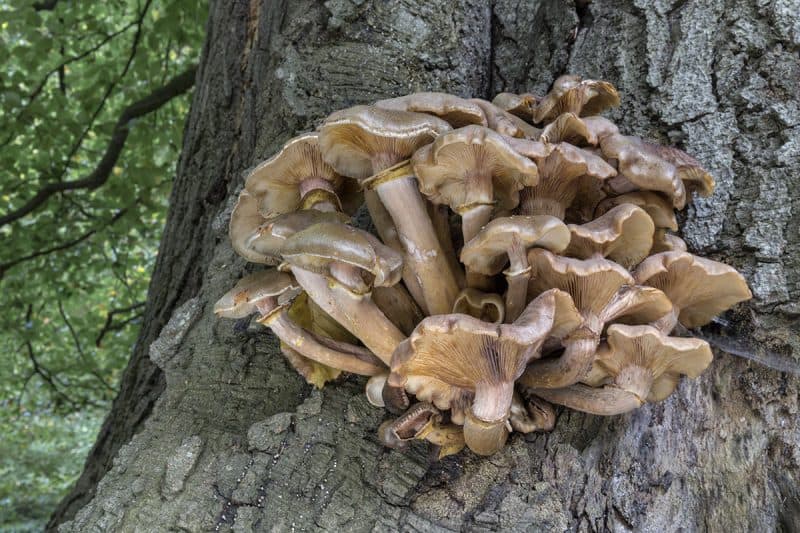
Unfortunately, armillaria root rot cannot be controlled once it’s taken over your pear trees. You have to remove diseased or dead plants entirely, including all the roots. If you leave the dead roots in the soil, the fungus continues to live. The best way to prevent armillaria root rot is to plant resistant rootstocks.
2. Blast
Blast is a bacterial disease that prefers cold, wet weather. It starts by causing water-soaked or black lesions to form on the leaf petioles that rapidly expand along the midrib. The leaves on the plant will turn black and die. Blast also causes cankers on the twigs and branches, and they often die as well.
This bacterial disease even causes black lesions to appear on the pear fruits.
If the disease is severe, copper fungicides can be applied to the fruit trees in the fall and winter. You might need multiple applications to get rid of the disease.
3. Crown, Collar and Root Rot
While it isn’t as common as some other diseases, your pear trees might struggle with crown, collar, or root rot. Crown rot occurs in the rootstock bark tissue, while root rot impacts the roots. Collar rot impacts the scion portion of the tree (the part above the graft joint).
This disease usually emerges when there is poorly draining soil and standing water around your pear tree. It’s caused by the pathogen Phytophthora.
Crown, collar, and root rot cause the leaves to wilt on your tree, but they will remain attached. You’ll notice that the tree has reduced growth, and there might be cankers on the trunk at the soil level. The bark will be discolored and slimy when wet.
Unfortunately, no treatment for these rots is effective. Prevention is the best option, including proper water management and never over-watering your pear trees.
4. Fire Blight
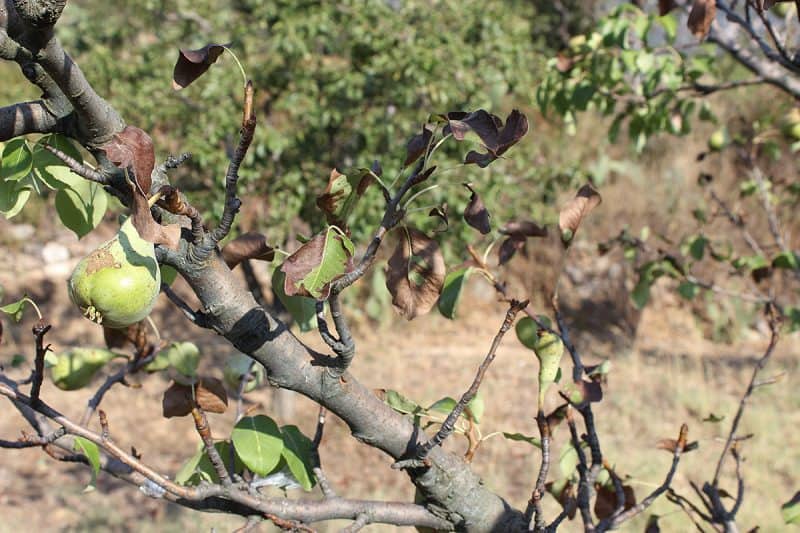
Most fruit trees owners have heard of fire blight; it’s one of the more dreaded pear tree diseases. It infects a range of fruit trees and bushes. This bacterial disease causes the shoots and blossoms on your fruit tree to shrivel and turn black. It looks like the plant has been scorched by fire, hence the name.
Fire blight likes warm, rainy days when the fruit trees are in bloom. If you find that your pear tree has fire blight, you need to remove all diseased wood and treat your fruit tree with a Bordeaux mixture or an approved copper treatment. These may help stop the spread of the disease.
Take a look at our guide on dealing with fire blight on your plants.
5. Pear Decline
Pear decline is a phytoplasma disease that is transmitted by the pear psylla pest. It causes poor shoot growth and the dieback of shoots on your tree. You will notice the reddening and rolling of the upper leaves in the canopy of your pear tree, along with premature leaf drop. Pear decline also causes reduced leaf and fruit size on your tree.
Getting rid of pear decline on your trees isn’t possible. No treatment is truly effective. The best options that you have are to plant resistant or tolerant rootstocks and control pear psylla on your trees.
6. Scab
If you notice yellow or chlorotic spots on the leaves of your pear tree, you might have scab. Scab is a fungal disease that causes a range of symptoms, like yellow or dark green spots on the leaves and fruits of your tree. There might be velvety growth on the underside of your leaves.
Scab also causes twisted or distorted leaves. A severe infection will cause the leaves on your tree to turn yellow and drop away. Unfortunately, this fungus overwinters on the dead foliage on the ground, and since spores are spread by wind, it’s often hard to get rid of this disease.
Prevention is always the first line of defense, but if your pear trees end up with scab anyway, try a fungicide application, such as copper soaps or a Bordeaux mixture. Make sure you always remove all dropped leaves from the area and consider adding a fungicide to areas near your pear trees where leaves remain wet for long periods.
7. Septoria Leaf Spot
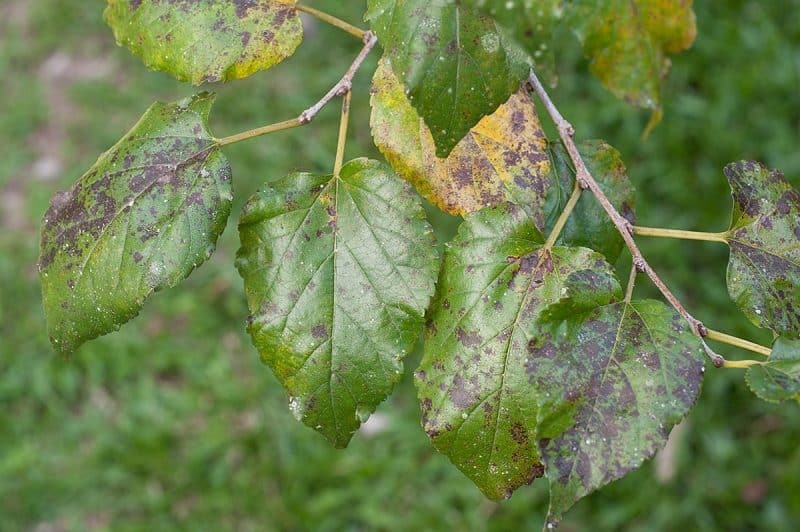
Septoria leaf spot is a fungal disease that is common on pear trees. It’s one of the most destructive fungal problems, and it loves areas that are wet and humid for long periods. This fungus overwinters on infected debris, so clearing away the fallen leaves is a must if you grow any type of fruit tree.
This infection stays mainly on the foliage and the upper surface of the leaves. You might notice grayish-white spots with a purple margin that becomes better defined at maturity. As the disease progresses, it causes the leaves to fall off the pear tree in the late summer.
You can take a look at our guide to septoria leaf spot in your garden.
